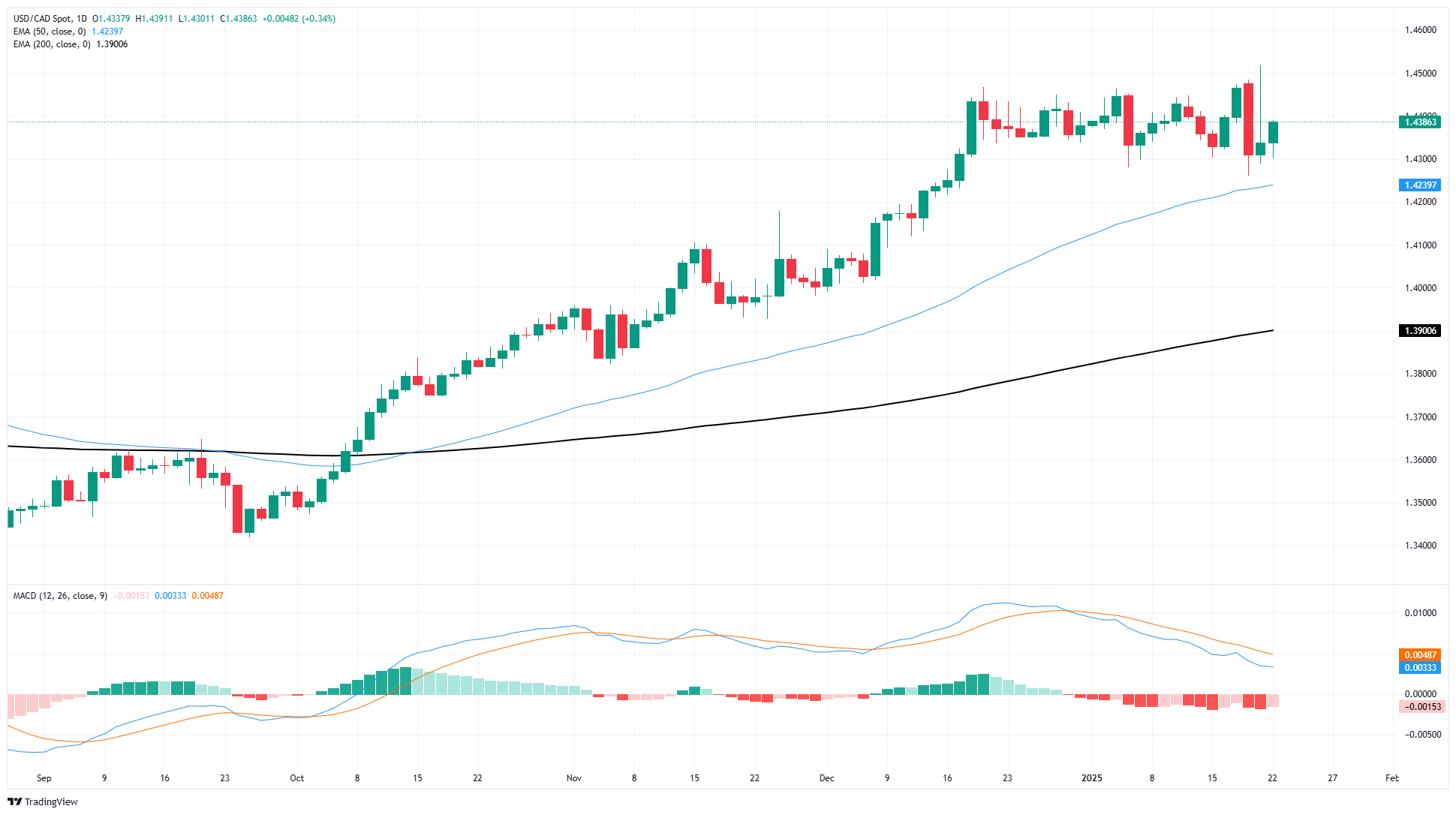- The Canadian Dollar stumbled again on Wednesday, becoming exposed near 1.4400.
- Canada’s economic data remains weak and the BoC is set for another rate cut.
- The Fed has dug in ahead of its own rate decision next week.
The Canadian Dollar (CAD) fell on Wednesday, returning to familiar mid-levels with USD/CAD stuck near the 1.4400 level. Data releases on either side of the 49th parallel are limited throughout the midweek market sessions, leaving CAD and Dollar traders awaiting the next round of central bank action on rates. of interest for next week.
Both the Bank of Canada (BoC) and the Federal Reserve (Fed) will make rate statements next week, but the results are set to diverge firmly. The BoC is heading toward another quarter-point rate cut to end this month, while the Fed is expected to keep rates unchanged through the first half of 2025. Canada’s retail sales figures are due out on Thursday, but the November data, which is already overdue, probably won’t generate much volatility. The US Purchasing Managers’ Index (PMI) survey results are scheduled for Friday, but not much is expected from them either.
Daily Market Summary: Canadian Dollar Steady as Markets Await Signs
- The BoC is overwhelmingly expected to deliver another 25 basis point rate cut next week.
- The Fed is expected to keep rates unchanged for most of the first half, further widening the USD/CAD rate differential.
- The Canadian Dollar lost another third of a percent against the Greenback, remaining stuck in a familiar congestion.
- CAD traders are watching for any headlines from US President Donald Trump about possible trade tariffs on all Canadian goods exported to the US.
- Canada’s retail sales numbers due out on Thursday likely won’t move the needle unless the numbers deviate significantly from expectations.
Canadian Dollar Price Forecast
The Canadian Dollar is stuck in a consolidation phase against the US Dollar, taking USD/CAD in a slow circle around the 1.4400 level. Mid-week price action remains subdued, and Wednesday’s 0.35% move only sees the CAD further entrenched in a sideways move.
The bid action at the top of the USD/CAD continues to see the Canadian Dollar testing multi-year lows, and technical indicators are beginning to break down, drifting towards the mid-range as the pair fails to advance and bearish momentum misses an opportunity to take a pivot from overbought conditions.
USD/CAD Daily Chart
Canadian Dollar FAQs
The key factors that determine the price of the Canadian dollar (CAD) are the level of interest rates set by the Bank of Canada (BoC), the price of oil, Canada’s main export product, the health of its economy, inflation and the trade balance, which is the difference between the value of Canadian exports and its imports. Other factors are market confidence, that is, whether investors bet on riskier assets (risk-on) or look for safe assets (risk-off), with the risk-on being positive for the CAD. As its largest trading partner, the health of the US economy is also a key factor influencing the Canadian dollar.
The Bank of Canada (BoC) exerts significant influence over the Canadian Dollar by setting the level of interest rates that banks can lend to each other. This influences the level of interest rates for everyone. The BoC’s main objective is to keep inflation between 1% and 3% by adjusting interest rates up or down. Relatively high interest rates are usually positive for the CAD. The Bank of Canada can also use quantitative easing and tightening to influence credit conditions, with the former being negative for the CAD and the latter being positive for the CAD.
The price of oil is a key factor influencing the value of the Canadian Dollar. Oil is Canada’s largest export, so the price of oil tends to have an immediate impact on the value of the CAD. Generally, if the price of oil rises, the CAD also rises, as aggregate demand for the currency increases. The opposite occurs if the price of oil falls. Higher oil prices also tend to lead to a higher probability of a positive trade balance, which also supports the CAD.
Although inflation has traditionally always been considered a negative factor for a currency, as it reduces the value of money, the opposite has actually happened in modern times, with the relaxation of cross-border capital controls. Higher inflation often leads central banks to raise interest rates, attracting more capital inflows from global investors looking for a lucrative place to store their money. This increases the demand for the local currency, which in the case of Canada is the Canadian Dollar.
The published macroeconomic data measures the health of the economy and may have an impact on the Canadian dollar. Indicators such as GDP, manufacturing and services PMIs, employment and consumer confidence surveys can influence the direction of the CAD. A strong economy is good for the Canadian dollar. Not only does it attract more foreign investment, but it may encourage the Bank of Canada to raise interest rates, resulting in a stronger currency. However, if economic data is weak, the CAD is likely to fall.
Source: Fx Street
I am Joshua Winder, a senior-level journalist and editor at World Stock Market. I specialize in covering news related to the stock market and economic trends. With more than 8 years of experience in this field, I have become an expert in financial reporting.







